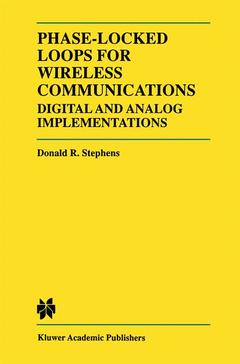Description
Phase-Locked Loops for Wireless Communications, Softcover reprint of the original 1st ed. 1998
Digital and Analog Implementation
Author: Stephens Donald R.
Language: English
Keywords
Modem; Phase; Z-Transformation; analog; circuit; communication; material; software
Approximative price 52.74 €
In Print (Delivery period: 15 days).
Add to cart
Publication date: 10-2012
379 p. · 15.5x23.5 cm · Paperback
379 p. · 15.5x23.5 cm · Paperback
Description
/li>Contents
/li>Readership
/li>
This book is intended for the graduate or advanced undergraduate engineer. The primary motivation for writing the text was to present a complete tutorial of phase-locked loops with a consistent notation. As such, it can serve as a textbook in formal classroom instruction, or as a self-study guide for the practicing engineer. A former colleague, Kevin Kreitzer, had suggested that I write a text, with an emphasis on digital phase-locked loops. As modem designers, we were continually receiving requests from other engineers asking for a definitive reference on digital phase-locked loops. There are several good papers in the literature, but there was not a good textbook for either classroom or self-paced study. From my own experience in designing low phase noise synthesizers, I also knew that third-order analog loop design was omitted from most texts. With those requirements, the material in the text seemed to flow naturally. Chapter 1 is the early history of phase-locked loops. I believe that historical knowledge can provide insight to the development and progress of a field, and phase-locked loops are no exception. As discussed in Chapter 1, consumer electronics (color television) prompted a rapid growth in phase-locked loop theory and applications, much like the wireless communications growth today. xiv Preface Although all-analog phase-locked loops are becoming rare, the continuous time nature of analog loops allows a good introduction to phase-locked loop theory.
Preface. 1. The Early History of Phase-Locked Loops. 2. Analog Phase-Locked Loops. 3. Root Locus and Frequency Analysis. 4. Acquisition and Tracking. 5. Digital Transforms. 6. Digital Closed Loop Analysis. 7. Digital Transformations of Analog Phase-Locked Loops. 8. Stability and Frequency Response of Digital Loops. 9. All Digital Phase-Locked Loops. 10. Digital PLL Responses and Acquisition. 11. Synchronizers for Digital Communications. 12. Phase Noise Analysis. Appendix A: Laplace Transforms. Appendix B: Z Transforms. Index.
Engineers and graduate students.
© 2024 LAVOISIER S.A.S.




